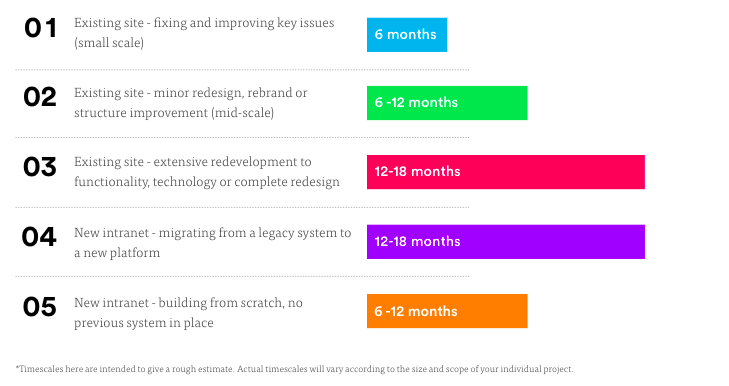While the features and functionalities of a fully deployed intranet can transform your business, it’s the early stages that can overwhelm a project manager. With so many individual components to attend to, how do you lead an intranet project successfully?
One of the many things the pandemic exposed was the digital weak spots within our businesses. With the workplace in the middle of profound, permanent change, organizations are trying to get a clear idea of what they need to do to improve their current tech stack.
Shifts in the ways of working have created a dispersed, virtual workplace, which has meant that more businesses have started to look at introducing intranet software into their organizations. As we know, a company intranet can transform remote working, connect enterprises and boost engagement – but as internal communicators and managers of this digital change, how do we successfully handle this kind of undertaking in a time of such uncertainty?
The problem most intranet managers face is that a project of this kind is an unknown ratio. Every organization encounters different challenges. Depending on your business, you may be up against stakeholders, pushback from the IT department, an impartial workforce, a digitally uninitiated culture, bad memories of a legacy intranet, or simply a reluctance to invest in new software.
And while the rewards of an implemented intranet will be multifold, the beginning of your intranet journey is unlikely to be straightforward. A lot of the initial hard work will involve overcoming your unique set of challenges.
So, how do you lead an intranet – and what information can you forearm yourself with before you start your project?
Your intranet project team

First of all, it’s important to remember that while there is a formula to building an intranet, the people responsible for the build can differ from business to business. Some of the largest enterprises have very small intranet teams. Some of the most successful projects have been the labor of one person. Others have more flexible setups and have enjoyed more resources. Whatever your group’s structure, it’s essential to remember that it is possible to build an intranet with one person, just as it is with a team of ten.
Getting the right people behind your intranet project, both during the implementation and to manage your intranet after launch, is critical to its success. Planning your team is not only important for determining your project resource requirements. Defined roles and responsibilities will also reduce many common risks such as project overrun, lack of accountability or ownership, or poor governance and direction for your intranet. While every organization should plan its unique governance and team structure to match its culture and objectives, there are some basics to consider when identifying who needs to be involved, and what their role may include.
Tasked with improving your internal comms?
Of course, your direct team will be the hub of activity throughout the project. Their roles as centralized management of the intranet day-to-day involve commitment, engagement, and working closely together. But their roles are indispensable: without their management, your intranet risks becoming out of date, sprawling, unfocused or unused.
Work with stakeholders to develop and execute intranet strategy. Day-to-day management of intranet including creating and managing structure, or setting and maintaining homepages
Work with content owners and publishers to check and review content, enhance search optimization, and adhere to content strategy and management principles. Ongoing training of publishers and familiarization for users
Recognize key people

While you assemble your intranet team, whether they’re full-time or part-time, it’s vital that you are able to recognize the value of other key figures in your organization. These people won’t be directly involved in the day-to-day build but their positions are such that they can offer huge value to your intranet throughout its journey.
These people can help determine the success of your project through a combination of support, expertise, and seniority. Some of these will include:
C-Level Directors: This group has the power and influence to create real change in your organization – not just procedurally but culturally. Their roles involve signing off and supporting the intranet’s purpose and objectives and enhance and develop the intranet project in line with organizational objectives. With their seniority within the business, they are influential in leading change and helping break down barriers preventing the intranet from fulfilling its potential. And by being the top-level of the business, they are the usual escalation point for stakeholder and intranet management for unsolved issues.
Tasked with improving your internal comms?
Stakeholders: Stakeholders have overall responsibility for delivering intranet success. They are sufficiently senior to have a broad view of company objectives and are well connected to the organization’s needs and the other senior leaders. Working with intranet management, C-Level, and the organization as a whole, they can help to plan and execute the intranet strategy while enhancing and developing the intranet in line with organizational objectives. Stakeholders are also key to chairing governance meetings as well as reporting to C-Level on the progress of intranet strategy, and escalating issues where required.
Content Leads: When we talk about content leads, we normally mean directors or heads of department. Their role normally involves around being accountable for the content published to the intranet by their department, ensuring the validity, accuracy, and usefulness of material. They can provide content publisher resource and support the publisher in keeping content up to date. They are able to work with stakeholders and intranet management to adhere to content strategy and management principles as well as respond to requests from intranet management and work to resolve issues.
IT Support: It’s IT’s role to consult on the strategic role and any technical concerns of the intranet. They can consult and assist with technical aspects regarding hosting, security, and user management and support for integration and digital workplace management. It’s also up to IT to ensure validity of user management source and help troubleshoot technical problems. While you should aim to rely on IT as little as possible, they do have an essential role to play in the implementation of your intranet software.
Resource

An intranet project needs a great deal of planning. Not only is it essential to plan what will constitute your intranet – but how you’re going to go about it. As the person in charge, how do you lead a project that involves so many people, resources, considerations?
Your intranet project will have a significant impact on your business during the process. The trick is to understand the size of this impact, and make stakeholders aware of this so that you can plan for extra support, create realistic timescales and reduce frequent project risks before the tasks get underway.
75% of business and IT executives anticipate their software projects will fail, and less than a third of all projects were successfully completed on time and on budget over the past year.
Capterra
Your business leaders may feel uneasy about firming up plans for something that requires spend and resource. However, you can adjust this, by laying out how transformational an intranet can be to a business experiencing change. By providing them with the intranet’s purpose, how it can define the business’s growth, how it aligns with strategic direction and the cost and returns, you will address their chief concerns and be in a position to bargain for the resources you need.
Your intranet provider will provide an intranet strategist to provide you with a breakdown of what you need over what time period. This person will help you take stock of where you stand, understand what you’re looking to accomplish, and help you create an intranet project plan that is tailored to you.
Acceptance and adoption

The most fundamental thing to remember is that a successful intranet is centered on its users. No matter what governance model you choose, keep them front-of-mind as the driving force for all major decisions around your intranet. Next, we set out the example roles and responsibilities for an intranet project and ongoing management. This will differ from one business to another; some of the roles may overlap, others may be redundant for your organization. If you are a small business with limited resource availability, several of the roles may be conducted by one person.
Any change, new tech, different protocol is bound to cause discontent in some areas of your business. Introducing something as transformative as new intranet software will inevitably cause some pushback.
When it comes to your company intranet, though, user adoption is one of the most critical indicators of success. When you’re under pressure to justify the investment to the C-suite, to demonstrate ROI, and to meet those all-important objectives, getting staff to log on is absolutely fundamental.
Part of your strategy should counter this, with Q&A sessions, feedback opportunities, and pulse surveys to allow this section to be heard. There are several other ways you can secure this all-important user adoption:
Involve your workforce from the beginning: If they’ve had input into design decisions along the way, fed upwards their needs, requirements, and challenges, or simply seen the evolution of your project from concept to tangible tool, they’re far more likely to understand the value of your intranet and be invested in its use and success.
Explain what issues the intranet will solve: Defining your intranet purpose and why your organization needs this tool is the starting point; but it’s also something you need to keep in mind every step of the design and delivery process.
Stage how-to workshops: One of the key hindrances in software adoption is simply not knowing how to use it. Provide employees with the right training, and confidence – and interest – will grow.
62% of employees feel that they lack skills and their employers don’t offer enough training and support
IBM
Position your intranet as the news site: By driving news, updates, customer success stories, and information away from email and bulletin boards and over to your intranet instead, you establish it as the go-to destination for everything employees need to know.
Tasked with improving your internal comms?
Establishing this relationship is the difference between success and failure for your intranet, and there are plenty of other ways you can win your workforce over to use your intranet. You can head here for more tips.
Cheerleaders wanted

While the passion you have for your project is essential, one person’s enthusiasm can only go so far in a business. To have a wider reach, it’s hugely beneficial to appoint cheerleaders or champions within your organization. These will be people you handpick outside of your build team, to provide feedback, suggestions, and general positivity towards the incoming software.
Like influencers on social media, these individuals will provide a positive voice for your project, enthusing those they work closely with in areas for the business that you may struggle to engage with easily.
But how do you get these people on board? Intranet champions result from you, as intranet leader, speaking to them about their own personal pain points within their role. In this conversation, you set about solving these problems with some intranet-based solutions. When you present your platform as able to overcome many different challenges, you slowly win their support as they see how advantageous it is to their roles. The same goes for execs and management who have a significant role in driving your project’s success. Once you offer them the chance to solve many of their day-to-day issues, the more open they will be to offer resources for the project.
Plan your timescales

The duration of time you need to schedule in for your intranet build depends on your situation. If all your resources are internal, you need to consider how your employees will juggle this project alongside their usual day-to-day activities. It’s essential to make sure that intranet team roles and responsibilities are agreed, documented, and clarified upfront: individuals should know what is expected of them, both during the project and in the long-term. If roles or responsibilities change, the handover needs to be documented and agreed by all major stakeholders.
How long an intranet will take is always high on the priority list for senior stakeholders. Still, as any project manager will testify, there is no clear-cut answer. Timescales will vary according to scope; solution selected, customization requirements, size and complexity of the organization, hosting/hardware requirements, the volume of content, internal processes, and more. As a rough guide, the chart below shows how differences in scope – whether this is a new project or redevelopment of an existing site – could impact on timescales.

Working through your plan, many of the timescales will become evident. Be realistic and allow for contingency events and margin for error or delay. Break down your project into crucial stages, and establish any deliverables required for each step: for example, when your senior stakeholders need to sign off on the final design or when the first wave of content needs to be migrated or built.
What type of intranet do you need?

Broadly speaking, there are two types of intranet package – customized and out-of-the-box. So, what you want your intranet to achieve and what challenges it will solve will determine what option you go for. In the very early stages of your planning, you will need to map out the list of every departmental priority – as these will call for different features and functionality.
With this information, you can see whether an out-of-the-box intranet is an ideal choice or whether you need a more customized solution. If your business has unique processes, needs to make significant modifications, or faces heavy restrictions due to data protection or compliance guidelines, such as a need to be HIPAA compliant, this all needs to be factored in.
You’ll also need to consider whether you will ‘build’ your own solution, or if your requirements and customizations can be applied to a bought solution. Our blog on ‘build vs. buy‘ explores the unique challenges and debates around this choice.
With so many considerations, an intranet project may feel like too tall an order. But millions of businesses have built their platforms to great success, enjoying high engagement levels and user satisfaction. And as with anything, it is those early stages of planning, projections, and proposals that will align your project to the right tracks. While you may be the central hub, there is a wealth of resource, help, and support within your business that can be easily tapped into once there is clear understanding of the purpose and benefits of this new tech.






